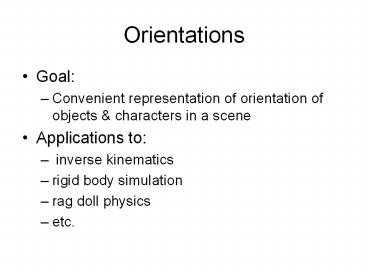Orientations - PowerPoint PPT Presentation
Title:
Orientations
Description:
Orientations Goal: Convenient representation of orientation of objects & characters in a scene Applications to: inverse kinematics rigid body simulation – PowerPoint PPT presentation
Number of Views:98
Avg rating:3.0/5.0
Title: Orientations
1
Orientations
- Goal
- Convenient representation of orientation of
objects characters in a scene - Applications to
- inverse kinematics
- rigid body simulation
- rag doll physics
- etc.
2
Euler Angles
- so far, used one angle per axis, ie. Euler
angles. - Pros
- Simple!
- Cons
- Singularities (gimbal lock)
- Interpolation is tricky
- Composing rotations is tricky
3
Singularities
- Singularities may arise when axes are rotated to
coincide - Lose a degree of freedom
- Consider an airplanes roll-pitch-yaw
- eg. (0,90,0) vs. (90,90,90) identical position
- IK problems
- Infinitely many solutions if coincident
- Ill-posed when very close to coincident
4
Interpolation
- Vital for keyframe animation, blending mocap
data, etc. - Linear interpolating each angle independently
gives odd behaviour near singularities - Not coordinate independent
- For 2 orientations, rotate-interpolate gives a
different result than interpolate-rotate
5
Composition
- Given two rotations applied sequentially, find a
single orientation that gives the same result. - Not at all obvious how to handle this
6
3x3 Orthogonal Matrices
- Eliminate many issues of Euler angles, but
- Hard to work with 9 components, 6 constraints
- Highly redundant
- Linear interpolation doesnt work
7
3x3 Orthogonal Matrices
- But
- Very effective for quickly transforming many
points - Composition is straightforward multiply
- Still useful, but not as our primary
representation
8
Axis-angle
- Unit axis vector and an angle indicating how much
to rotate. - Very intuitive
- 4 numbers, 1 constraint less redundant
- Comparison, interpolation, composition still
difficult.
9
2D Rotations
- Can use complex numbers to represent 2D rotations
- View a point (x,y) as x iy
- Rotation about origin is multiplication by
- cos(theta) isin(theta)
- Equivalently, e(itheta)
- ie. A unit magnitude complex number
10
2D Rotations
- And composition is again multiplication
- Isnt this overkill?
- In 2D, yes
- But this idea extends elegantly to 3D
11
Quaternions
- Generalizes complex numbers
- Two additional sqrt(-1) terms, j and k
- Form a bi cj dk
- Behave mostly like regular numbers
- But NOT commutative! ab ? ba
12
Quaternions
- Small set of simple multiplication rules
- ii -1, jj -1, kk -1
- ij k, jk i, ki j
- ji -k, kj-i, ik -j
- When j k components are 0, this reverts to
basic complex numbers - ie. 2D rotations.
13
Rotating points
- Given complex number
- Conjugate is
- Then
- If q is unit magnitude, just gives back 0 ix
- Real part remains 0, imaginary part retains its
length, x
14
Rotating points
- Quaternion
- Conjugate
- Zero real-part quaternion
- Consider
- Real part stays 0, imaginary part keeps length
- For unit q, this is a rotation of the vector
(x,y,z) in quaternion form
15
Quaternion Rotation
- So, to perform a rotation by unit quaternion q on
vector v (x,y,z) to get new vector v
(x,y,z) just do
16
Quaternion Rotation
- Unit-length quaternions can represent any
orientation in 3D, without singularities - Relation to axis-angle form
- Real part is cos(theta/2)
- Imaginary part is vector parallel to the rotation
axis - Redundancy q -q
- But since the two possible representations are
maximally far apart, no harm done.
17
Quaternion Interpolation
- Interpolation is much more convenient
- linear interpolating, then renormalizing q to
unit-length works fairly well - For better results, ensure dot product of their
imaginary parts is non-negative,by flipping sign,
since q -q is the same orientation. - We want the two quaternions axes to be
pointing in the same direction, so that the
interpolation path is as short as possible. - For improved interpolation of unit vectors, look
into slerp
18
Quaternion Composition
- Similar to matrix form, just multiply
- Consider 2 quaternion rotations applied to a
point 0ixjykz - or































